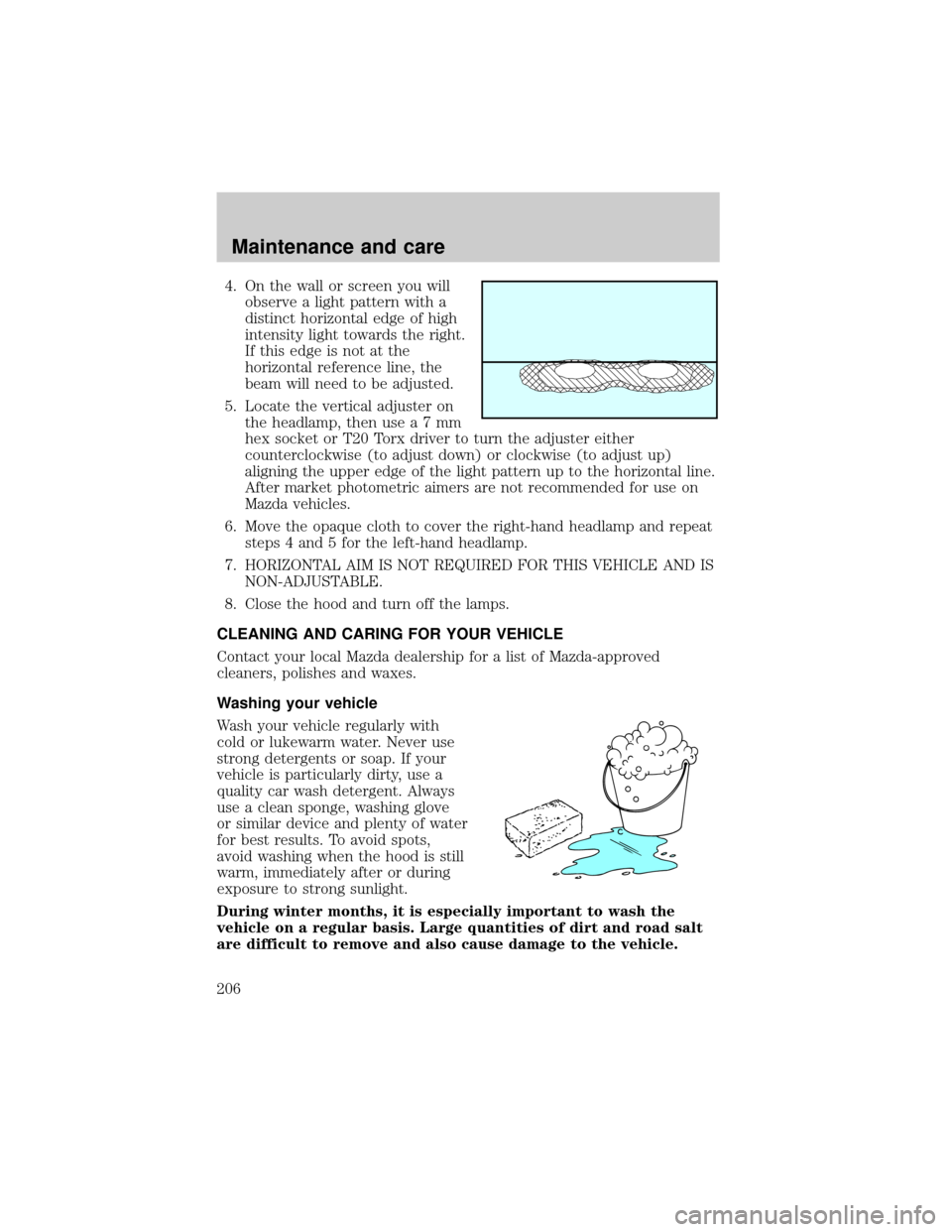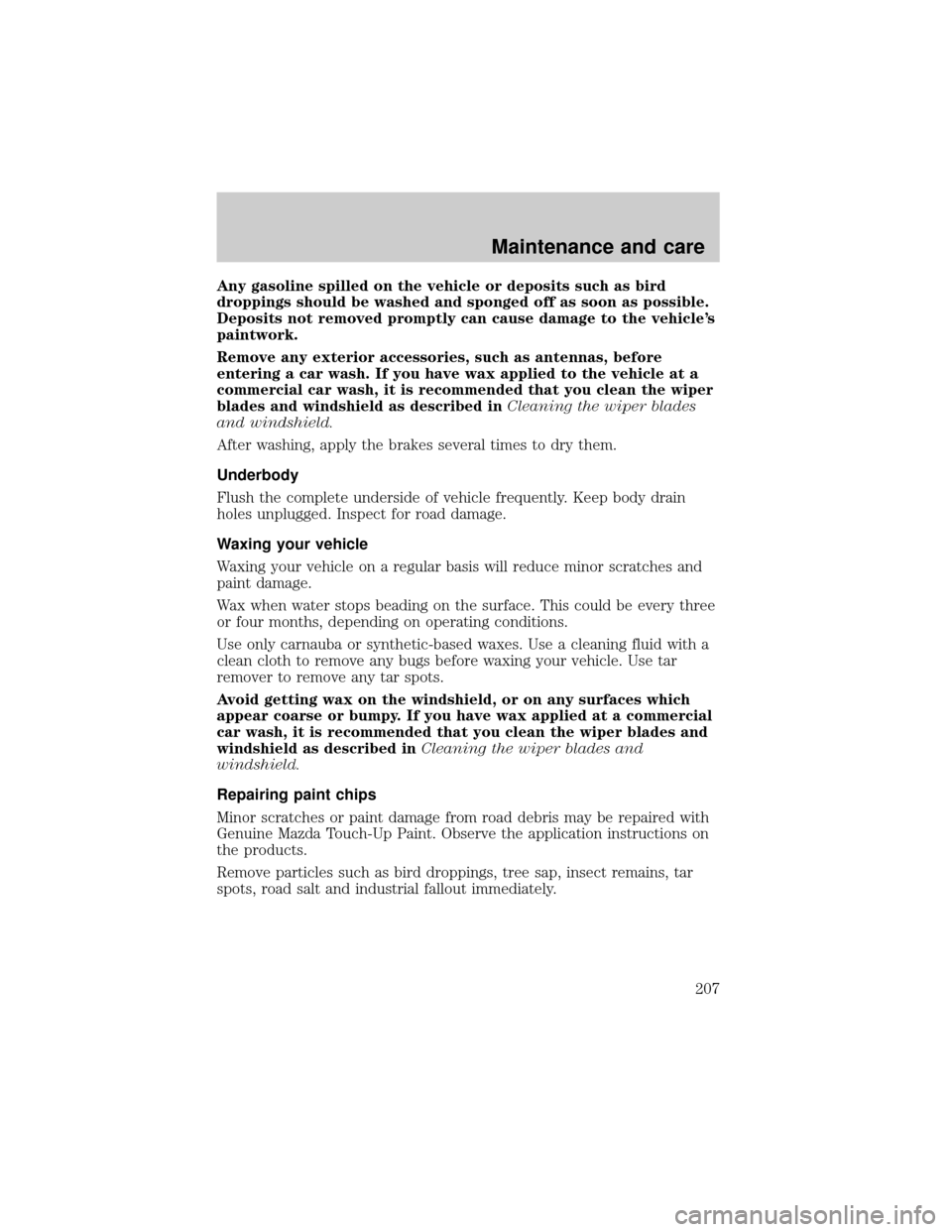Page 205 of 232
AIMING THE HEADLAMPS
The headlamps on your vehicle are properly aimed at the assembly plant.
If your vehicle has been in an accident the alignment of your headlamps
should be checked by your authorized Mazda dealer.
VERTICAL AIM ADJUSTMENT
1. Park the vehicle on a level surface approximately 7.6 meters
(25 feet) from a vertical wall or screen directly in front of it.
²(A) 2.4 meter (8 feet)
²(B) Center height of lamp to ground
²(C) 7.6 meters (25 feet)
²(D) Horizontal reference line
2. Measure the height from the center of your headlamp to the ground
and mark a 2.4 meter (8 foot) horizontal reference line on the
vertical wall or screen at this height (a piece of masking tape works
well). The center of the lamp is marked by a 3.0 mm circle on the
headlamp lens.
3. Turn on the low beam headlamps to illuminate the wall or screen
and open the hood. Cover the left-hand headlamp with an opaque
cloth.
A
D
B
C
Maintenance and care
205
Page 206 of 232

4. On the wall or screen you will
observe a light pattern with a
distinct horizontal edge of high
intensity light towards the right.
If this edge is not at the
horizontal reference line, the
beam will need to be adjusted.
5. Locate the vertical adjuster on
the headlamp, then usea7mm
hex socket or T20 Torx driver to turn the adjuster either
counterclockwise (to adjust down) or clockwise (to adjust up)
aligning the upper edge of the light pattern up to the horizontal line.
After market photometric aimers are not recommended for use on
Mazda vehicles.
6. Move the opaque cloth to cover the right-hand headlamp and repeat
steps 4 and 5 for the left-hand headlamp.
7. HORIZONTAL AIM IS NOT REQUIRED FOR THIS VEHICLE AND IS
NON-ADJUSTABLE.
8. Close the hood and turn off the lamps.
CLEANING AND CARING FOR YOUR VEHICLE
Contact your local Mazda dealership for a list of Mazda-approved
cleaners, polishes and waxes.
Washing your vehicle
Wash your vehicle regularly with
cold or lukewarm water. Never use
strong detergents or soap. If your
vehicle is particularly dirty, use a
quality car wash detergent. Always
use a clean sponge, washing glove
or similar device and plenty of water
for best results. To avoid spots,
avoid washing when the hood is still
warm, immediately after or during
exposure to strong sunlight.
During winter months, it is especially important to wash the
vehicle on a regular basis. Large quantities of dirt and road salt
are difficult to remove and also cause damage to the vehicle.
Maintenance and care
206
Page 207 of 232

Any gasoline spilled on the vehicle or deposits such as bird
droppings should be washed and sponged off as soon as possible.
Deposits not removed promptly can cause damage to the vehicle's
paintwork.
Remove any exterior accessories, such as antennas, before
entering a car wash. If you have wax applied to the vehicle at a
commercial car wash, it is recommended that you clean the wiper
blades and windshield as described inCleaning the wiper blades
and windshield.
After washing, apply the brakes several times to dry them.
Underbody
Flush the complete underside of vehicle frequently. Keep body drain
holes unplugged. Inspect for road damage.
Waxing your vehicle
Waxing your vehicle on a regular basis will reduce minor scratches and
paint damage.
Wax when water stops beading on the surface. This could be every three
or four months, depending on operating conditions.
Use only carnauba or synthetic-based waxes. Use a cleaning fluid with a
clean cloth to remove any bugs before waxing your vehicle. Use tar
remover to remove any tar spots.
Avoid getting wax on the windshield, or on any surfaces which
appear coarse or bumpy. If you have wax applied at a commercial
car wash, it is recommended that you clean the wiper blades and
windshield as described inCleaning the wiper blades and
windshield.
Repairing paint chips
Minor scratches or paint damage from road debris may be repaired with
Genuine Mazda Touch-Up Paint. Observe the application instructions on
the products.
Remove particles such as bird droppings, tree sap, insect remains, tar
spots, road salt and industrial fallout immediately.
Maintenance and care
207
Page 208 of 232
Cleaning the engine
Engines are more efficient when they are clean because grease and dirt
buildup keep the engine warmer than normal. When washing:
²Take care when using a power washer to clean the engine. The
high pressure fluid could penetrate the sealed parts and cause
damage.
²Do not spray with cold water when the engine is hot to avoid
cracking the engine block or other engine components.
²Never apply anything to the drive belt (including belt
dressing).
²2.0L DOHC I4 Ð Zetec Engine
²3.0L DOHC V6 Ð Duratec Engine
Maintenance and care
208
Page 209 of 232

²Cover the highlighted areas to prevent water damage when
cleaning the engine.
²Never wash or rinse the engine while it is running; water in the
running engine may cause internal damage.
Cleaning the wheels
Wash with the same detergent as the body of your vehicle. Do not use
acid-based or alcohol-based wheel cleaners, steel wool, fuel or strong
detergents. Never use abrasives that will damage the finish of special
wheel surfaces. Use a tar remover to remove grease and tar.
The brushes used in some automatic car washes may damage the
finish on your wheels. Before going to a car wash, find out if the
brushes are abrasive.
Cleaning non-painted plastic exterior parts
Use vinyl cleaner for routine cleaning. Clean with a tar remover if
necessary. Do not clean plastic parts with thinners, solvents or
petroleum-based cleaners.
Cleaning the exterior lamps
Wash with the same detergent as the exterior of your vehicle. If
necessary, use a tar remover.
To avoid scratching the lamps, do not use a dry paper towel, chemical
solvents or abrasive cleaners.
Cleaning the wiper blades, windshield and rear window
If the wiper blades do not wipe properly, clean the wiper blade rubber
element with undiluted windshield washer solution or a mild detergent.
To avoid damaging the blades, do not use fuel, kerosene, paint thinner or
other solvents.
If the wiper still does not wipe properly, this could be caused by
substances on the windshield or rear window such as tree sap and some
hot wax treatments used by commercial car washes. Clean the outside of
the windshield or rear window with a non-abrasive cleaner.Do notuse
abrasive cleansers on glass as they may cause scratches. The windshield
or rear window is clean if beads do not form when you rinse it with
water. The windshield, rear window and wiper blades should be cleaned
on a regular basis, and blades or rubber elements replaced when worn.
Maintenance and care
209
Page 210 of 232

Cleaning seats equipped with side air bags
Remove dust and loose dirt with a whisk broom or a vacuum cleaner.
Remove fresh spots immediately. Follow the directions that come with
the cleaner. Do not saturate the seat cover with upholstery cleaner.
WARNING: Do not use chemical solvents or strong detergents
when cleaning the seat where the side air bag is mounted. Such
products could contaminate the side air bag system and affect
performance of the side air bag in a collision. The air bag may
not function correctly and not provide injury reduction
benefits.
Cleaning the instrument panel
Clean with a damp cloth, then dry with a dry cloth.
Avoid cleaner or polish that increases the gloss of the upper portion of
the instrument panel. The dull finish in this area helps protect the driver
from undesirable windshield reflection.
WARNING: Do not use chemical solvents or strong detergents
when cleaning the steering wheel or instrument panel to avoid
contamination of the air bag system. The air bag may not
function correctly and not provide the injury reduction
benefits.
Cleaning the overhead console
Clean with a damp cloth, then wipe dry with a dry cloth.
Avoid cleaner or polish that increases the gloss of the console. The dull
finish in this area helps protect the driver from undesirable windshield
reflection.
Cleaning the interior fabric
Remove dust and loose dirt with a whisk broom or a vacuum cleaner.
Remove fresh spots immediately. Do not use household or glass cleaners.
These agents can stain and discolor the fabric. Use a mild soap and
water solution if necessary.
Maintenance and care
210
Page 211 of 232
Cleaning and maintaining the safety belts
Clean the safety belts with a mild soap solution recommended for
cleaning upholstery or carpets.
WARNING: Do not bleach or dye the belts, because these
actions may weaken the belt webbing.
Check the safety belt system periodically to make sure there are no
nicks, wear or cuts. If your vehicle has been involved in an accident,
refer to theSafety belt maintenancesection in theSeating and safety
restraintschapter.
Woodtone trim
Wipe stains with a soft cloth and a multi-purpose cleaning solution.
Inside windows
Use glass cleaner for the inside windows if they become fogged.
Cleaning mirrors
Do not clean your mirrors with a dry cloth or abrasive materials. Use a
soft cloth and mild detergent and water. Be careful when removing ice
from outside mirrors because you may damage the reflective surface.
Maintenance and care
211
Page 213 of 232

Fluid Classification Application Capacity
Transfer Case SAE 75W-140
Synthetic
Lubricant4X4 (Automatic) 0.35L (12
ounces)
API service
GL-5, SAE
80W-904X4 (Manual) 0.35L (12
ounces)
Engine coolant
4Use only
ethylene-glycol-
based coolant2.0L I4 Zetec
engine with
manual
transaxle5.0L (5.3
quarts)
3.0L V6 Duratec
engine with
automatic
transaxle10.0L (10.6
quarts)
Rear axle
lubricantSAE 80W-90
Premium Rear
Axle Lubricant4X4 1.4L (2.96 pints)
5
Windshield
washer fluidn/a All 2.6L (2.7
quarts)
1Ensure the correct automatic transmission fluid is used. Transmission
fluid requirements are indicated on the dipstick or on the dipstick
handle. MERCONtand MERCONtV are not interchangeable. DO NOT
mix MERCONtand MERCONtV. Refer to your scheduled maintenance
section to determine the correct service interval.
2Service refill capacity is determined by filling the transmission to the
bottom of the filler hole with the vehicle on a level surface.
3Indicates only approximate dry-fill capacity. Some applications may vary
based on cooler size and if equipped with an in-tank cooler. The amount
of transmission fluid and fluid level should be set by the indication on
the dipstick's normal operating range.
4Use Premium Engine Coolant (green in color). DO NOT USE Extended
Life Engine Coolant (orange in color). Refer toAdding engine coolant,
in the Maintenance and Care chapter.
5Fill to 6 mm to 14 mm (1/4 inch to 9/16 inch) below bottom of fill hole.
Capacities and specifications
213